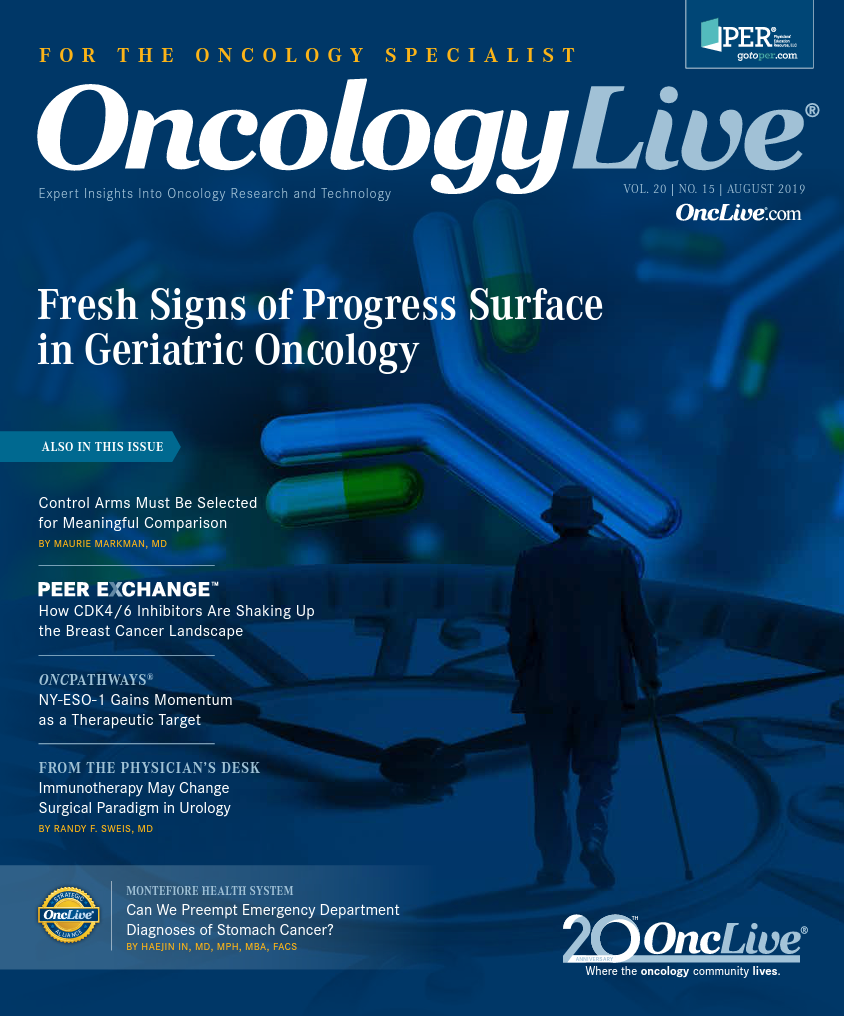Smoking, Vitamin D Deficiency Correlate to Ulcerated Melanoma
Ulcerated melanoma is associated with worse outcomes and appears to be driven in part by systemic inflammation, which is more common in smokers, obese individuals, and those with vitamin D deficiency.
Julia Newton-Bishop, MD

Julia Newton-Bishop, MD
Ulcerated melanoma is associated with worse outcomes and appears to be driven in part by systemic inflammation, which is more common in smokers, obese individuals, and those with vitamin D deficiency, according to melanoma expert Julia Newton-Bishop, MD, part of a team of investigators exploring genetic and environmental predictors of the immune response in patients with primary cutaneous melanoma.
In a recent study, smoking was found to result in poorer survival for patients with melanoma across immune response groups and independent of other risk factors, said Newton-Bishop, a professor of dermatology with the University of Leeds School of Medicine in England and the melanoma research group leader with the Leeds Institute of Medical Research at St James’s University Hospital.
In addition, the group has confirmed a negative correlation between Breslow thickness of melanoma tumors and serum vitamin D levels, which has been observed by other investigators and suggests an antiproliferative effect of vitamin D. Increased vitamin D/vitamin D receptor (VDR) expression is associated with thinner tumors, a lower mitotic rate, and lower-stage disease, Newton- Bishop said. Systemic inflammation may influence immune response, and inflammation reversal may be possible with the use of such agents as statins and IL-1β blockade, she added.
In addition, the group has found evidence of gene signatures that may predict for survival in primary melanoma subgroups and relapse in patients with stage I melanoma.
Figure. Ulcerated Versus Nonulcerated Melanoma
Newton-Bishop discussed these findings, along with the possibility of using vitamin D as a treatment option for melanoma, in a June presentation at the 3rd Annual Noreen O’Neill Melanoma Research Symposium at The Wistar Institute in Philadelphia, Pennsylvania. Investigators found that cigarette smoking reduces survival primarily in patients with strong immune response or inflammation. Overall, the hazard ratio for melanoma-specific survival among smokers was 1.56 (95% CI, 1.11-2.18; P = .003). However, the adverse effect of smoking was greatest in patients with the strongest immune response. For these individuals, the hazard ratio for melanoma-specific survival was 4.59 (95% CI, 1.68-8.23) compared with 1.78 (95% CI, 1.01-3.13) in the intermediate group and 0.92 (95% CI, 0.56-1.51) for the low-immune subgroup.1,2
“Smoking was a risk factor for melanoma death that was independent of factors like stage. No matter how thick the tumor was [or] the stage at which the patient presented, smoking increased their risk of dying from that tumor,” Newton-Bishop said in an interview. “There was some interplay, which we seek to understand, between the immune response to the cancer and smoking. Somehow smoking diminishes the value of having immune cell infiltration.”
For this study, Pózniak et al conducted bioinformatic analyses on 703 tumor transcriptomes collected from the Leeds Melanoma Cohort to determine immune cell infiltration. The tumors were then divided into the high—, intermediate–, and low–immune signaling groups.
“Genes in the low subgroup were enriched for cell-cycle and metabolic pathways, whereas genes in the high subgroup were enriched for IFN [interferon] and NF [nuclear factor]—κB signaling. We identified high MYC expression partially driven by amplification, HLA-B downregulation, and deletion of IFNγ and NF-κB pathway genes as the regulators of immune suppression,” investigators wrote, concluding that these findings combined with the insight into smoking risk for melanoma proliferation could help to predict for response to immunotherapy.
Investigators have found that systemic inflammation—common in smokers, obese patients, and those with vitamin D deficiency— is at least partially responsible for ulceration (Figure). Ulceration is associated with thicker tumors and poorer outcomes. Further, ulceration is associated with higher levels of fibrinogen, which contributes to poorer outcomes because it is a glycoprotein building block for tumor growth. Newton-Bishop hypothesized that smoking may drive this process of generalized inflammation.
“Inflammation is a complicated thing,” Newton-Bishop said. “The sort of inflammation that is good for patients is where their immune cells go in and kill the tumor cells. This is cytotoxic immunity— immune cells actually physically destroying tumor cells. But inflammation is a broad term that also covers a sort of ‘grumbling’ inflammation that stokes the fire of tumors. Smoking and systemic inflammation are associated with the sort of inflammation that’s bad.”
More Vitamin D is not Necessarily Better
Newton-Bishop was lead author in a 2015 study whose results showed that lower vitamin D levels, along with smoking, were associated with ulceration and poorer melanoma-specific survival.3 Serum levels of vitamin D measured at diagnosis were associated with a significantly better disease-specific outcome (HR, 0.89 per 10 nmol/L; 95% CI, 0.83- 0.95; P <.001) on univariate analysis. In multivariable analyses, the associations with death from melanoma were low 25-hydroxyvitamin D2/D3 levels at recruitment (<20 nmol/L vs 20-60 nmol/L; HR, 1.52; 95% CI, 0.97-2.40; P = 0.07) and smoking duration at diagnosis (HR, 1.11; 95% CI, 1.03-1.20; P = .009).
Increased vitamin D/VDR is associated with factors including better melanoma-specific survival. However, Newton-Bishop said she is currently working on a study whose results appear to show a limit to this beneficial effect. “Our data suggest that higher vitamin D levels are not particularly beneficial, but lower levels are harmful,” she said. She added that vitamin D levels vary by about a 20-nmol/L difference seasonally. “If the crucial cutoff is 25 nmol/L, then you need only [to maintain an average] of about 60 nmol/L year-round. The body has lots of checks and balances in place that are all about having the right level. We’re avoiding deficiency, aiming for steady levels.”
Newton-Bishop added that some evidence suggests that an immunosuppressive effect is associated with high levels of serum vitamin D, but the cutoff has not been established. Some preclinical evidence also suggests that vitamin D could represent a therapeutic option for patients with melanoma. Spath et al showed that circulating vitamin D serum consistently weakens melanoma cell proliferation and tumor growth in vitro and in vivo. Investigators concluded that these findings provide preclinical biological and clinical rationales for using vitamin D as adjuvant therapy for melanoma.4
Newton-Bishop said vitamin D should “absolutely” be of interest as a therapeutic option. “There are a number of drugs based upon chemical variants of the vitamin D molecule that increase the level of expression of vitamin D receptor,” she said. “It’s an important candidate.”
References
- Newton-Bishop JA. Environmental exposures, melanoma subtypes, and survival. Presented at: 3rd Annual Noreen O’Neill Melanoma Research Symposium; June 18, 2019; Philadelphia, PA.
- Pózniak J, Nsengimana J, Laye JP, et al. Genetic and environmental determinants of immune response to cutaneous melanoma. Clin Cancer Res. 2019;79(10):2684-2696. doi: 10.1158/0008-5472.CAN-18-2864.
- Newton-Bishop JA, Davies JR, Latheef F, et al. 25-Hydroxyvitamin D2/D3 levels and factors associated with systemic inflammation and melanoma survival in the Leeds Melanoma Cohort. Int J Cancer. 2015;136(12):2890-2899. doi: 10.1002/ijc.29334.
- Spath L, Ulivieri A, Lavra L, et al. Antiproliferative effects of 1α-OH-vitD3 in malignant melanoma: potential therapeutic implications. Sci Rep. 2017;7:40370. doi: 10.1038/srep40370.




